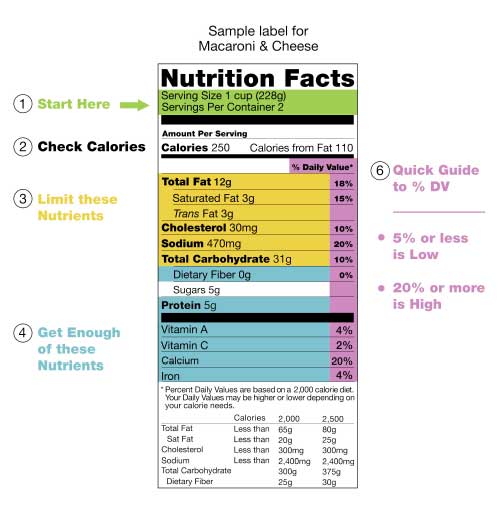Serving size
The amounts shown on the label refer to a single serving. Serving sizes are often much smaller portions than people generally eat in one sitting. Do the math to get the right numbers.
Ingredients
Ingredients are listed by quantity, from highest to lowest. Try looking for products that list whole foods as the first three ingredients, and be skeptical of foods with long lists of ingredients.
Calories
For many people, this is the first and most important stop on the label. But a higher-calorie food might be worth eating if it also contains lots of nutrients.
Fats
If most of the fat content comes from healthy unsaturated fat, you’re probably good to go. If the fat is mainly saturated and/or the product has any trans fat, put it back on the shelf. Trans fat has been shown to increase levels of “bad” LDL cholesterol while decreasing levels of “good” HDL cholesterol—a double health whammy.
Don’t be fooled by a label that lists 0 grams (g) trans fat. Because of a labeling loophole, a product can contain up to 0.5g trans fat per serving and claim it has none. Check the ingredient list: If it includes partially hydrogenated oil, then there is trans fat in there. Shortening is another source of trans fat.
Sugars
This number doesn’t distinguish between naturally occurring sugars (like lactose in milk or fructose in fruit) and added sugar (like high-fructose corn syrup or brown rice syrup).
If sugar is one of the first two ingredients, don’t bring it home. Ingredients are ordered by volume, so the higher up on the list an ingredient is, the more of it a product contains. This is an easy way to spot foods that include a lot of added sugar. (Naturally occurring sugar won’t be listed here.)
Sometimes, manufacturers split up sugar into dextrose, high-fructose corn syrup, cane crystals and so on, so none of them are the first ingredient, even though if you added them up, they would be. You definitely want to avoid any product if there is sugar in more than one form.
Food manufacturers often add many different kinds of sugar to their products so they can hide the actual amount. By doing this, they can list a “healthier” ingredient at the top, and mention sugar further down. So even though a product may be loaded with sugar, it doesn’t necessarily appear as one of the top 3 ingredients.
To avoid accidentally consuming a lot of sugar, it may be wise to look out for the following names of sugar in ingredient lists:
Types of sugar:
beet sugar, brown sugar, buttered sugar, cane sugar, caster sugar, coconut sugar, date sugar, golden sugar, invert sugar, muscovado sugar, organic raw sugar, raspadura sugar, evaporated cane juice and confectioner’s sugar.
Types of syrup:
carob syrup, golden syrup, high fructose corn syrup, honey, agave nectar, malt syrup, maple syrup, oat syrup, rice bran syrup and rice syrup.
Other Types:Other added sugars: barley malt, molasses, cane juice crystals, lactose, corn sweetener, crystalline fructose, dextran, malt powder, ethyl maltol, fructose, fruit juice concentrate, galactose, glucose, disaccharides, maltodextrin and maltose.
There are much more names for sugar, but these are the most common.

Carbohydrates
Carbohydrates are essentially everything that isn’t a fat or a protein. Some carbohydrates, like fiber, are not digested and have very little caloric effect. Most carbohydrates in packaged food are highly refined. In fact, two slices of whole wheat bread have a higher gylcemic index than a serving of Skittles candies! Some carbohydrates, such as those found in whole vegetables, are incredibly healthy, but these are comprised primarily of fiber.
Fiber
Look for at least 3g of fiber per serving in any product. Remember that your fiber count can be subtracted from the overall carbohydrates count, to get your accurate NET carbs. You need between 40 and 50 grams of fiber per day to lose weight.
Grains
Many people assume grains such as whole wheat are high in fiber. But two slices of whole wheat bread has less than 2 grams. If you see the word enriched before a grain, it’s a sign that the grain has been refined, meaning it has been stripped of the germ and bran that pack most of the grain’s nutrients, including fiber. In the NutraPro Plan, grains are forbidden because they spike your insulin and can cause weight gain.
Sodium
Excess sodium can raise blood pressure, which increases heart disease risk, and it may be a sign of a more highly-processed food. When sodium is paired with fats and sugars, they can make food highly addictive. Be very careful of foods that are higher than 800 milligrams (mg) per serving—about a third of the recommended daily limit for sodium (2,300 mg).
Vitamins & Minerals
The Daily Value (DV) is the amount of each nutrient that’s considered sufficient for most healthy adults. A food that contains anywhere from 10 percent to 19 percent of the DV is considered a good source of a nutrient.






